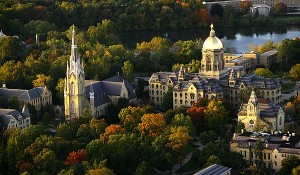 Yesterday I arrived at the University of Notre Dame in South Bend, Indiana — my first visit to this storied campus — to participate in the annual meeting of the Society for Literature, Science, and the Arts. This year the conference theme is “Postnatural.”
Yesterday I arrived at the University of Notre Dame in South Bend, Indiana — my first visit to this storied campus — to participate in the annual meeting of the Society for Literature, Science, and the Arts. This year the conference theme is “Postnatural.”
My talk yesterday afternoon was part of a panel entitled “Water and the City,” and included stimulating presentations by Christine Skolnik of DePaul University (“Imagined Eco-Futures” Restoring the Current” [of the LA River]) and Peter Hobbs of York University in Toronto (“What Does Lead Do? Toxic Entanglements, Exposures, and Cosmo-Chemo-Politics”).
Below is the introduction to my talk, which was an extemporaneous exposition of this slideshow (pdf, 10MB file).
Water and the Postnatural City: Reversals, Invasions, and Prospects for Sustainability
It is hard to think of a natural substance more vital to life than water. Yet, “the natural” is difficult to locate amidst the bewildering complex of intakes, filters, screens, pumps, chemical treatment chambers, distribution mains, pipes of all sizes, gutters, storm drains, sinks, sewers, settling tanks, combined sewage overflows, canals, locks, oxygenating waterfalls, electric fish barriers, and myriad other technological accouterments that allow us to convey, control, imbibe, and dispense with freshwater/wastewater in our cities and suburbs.

Despite the utter domination of water’s movement by what environmental engineers call the “hard path” of water resource management, however, the capacity of even highly degraded urban river corridors to support surprising levels of biodiversity — not to mention the tendency of urbanized landscapes to flood — demonstrates that Nature in the form of wild (read: violent) water frequently reasserts its power over us.
This presentation takes a deep dive into the water resources and management systems of the Chicago Region to ask:
- What does it mean for the aptly named Chicago Area Waterway System to be “postnatural,” and why has it been such for so many decades?
- How does a dredged, straightened, polluted, reversed, flushed, rerouted, industrialized, and biologically invaded since the mid-19th century urban river become a locus of urban sustainability and ecological restoration in the 21st century?
- In what ways are Chicago’s rivers and canals connected to its other vital water resources and systems: fresh water supply (intake) and wastewater (outflow)?
- Finally, what might the salient tropes of various Water and the City narratives teach us about our capacity to explore and apprehend an urbanized but still wild (read: unpredictable) nature in a postnatural age?